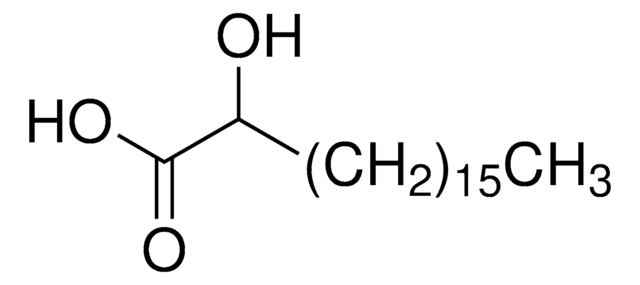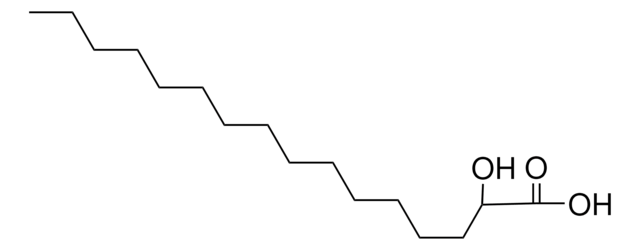SML0256
2OHOA
≥98% (HPLC)
Synonyme(s) :
(9Z)-2-Hydroxy-9-octadecenoic acid; cis-2-Hydroxy-9-octadecenoic acid, 2-Hydroxy Oleic Acid, Minerval
About This Item
Produits recommandés
Pureté
≥98% (HPLC)
Conditions de stockage
protect from light
Couleur
white to tan
Solubilité
DMSO: >20 mg/mL
Température de stockage
room temp
Chaîne SMILES
CCCCCCCC\C=C/CCCCCCC(O)C(O)=O
InChI
1S/C18H34O3/c1-2-3-4-5-6-7-8-9-10-11-12-13-14-15-16-17(19)18(20)21/h9-10,17,19H,2-8,11-16H2,1H3,(H,20,21)/b10-9-
Clé InChI
JBSOOFITVPOOSY-KTKRTIGZSA-N
Application
- a modulator of the sphingolipid and glycerophospholipid pathway to study its effects on myelination in mice Charcot–Marie–Tooth type 1A (CMT1A) myelinopathy and myelinating dorsal root ganglia cultures
- in biophysical studies to study its effects on artificial membranes
- to study its interactions with major membrane lipid films
Actions biochimiques/physiologiques
Mention d'avertissement
Danger
Mentions de danger
Conseils de prudence
Classification des risques
Eye Dam. 1
Code de la classe de stockage
11 - Combustible Solids
Classe de danger pour l'eau (WGK)
WGK 3
Point d'éclair (°F)
Not applicable
Point d'éclair (°C)
Not applicable
Certificats d'analyse (COA)
Recherchez un Certificats d'analyse (COA) en saisissant le numéro de lot du produit. Les numéros de lot figurent sur l'étiquette du produit après les mots "Lot" ou "Batch".
Déjà en possession de ce produit ?
Retrouvez la documentation relative aux produits que vous avez récemment achetés dans la Bibliothèque de documents.
Les clients ont également consulté
Notre équipe de scientifiques dispose d'une expérience dans tous les secteurs de la recherche, notamment en sciences de la vie, science des matériaux, synthèse chimique, chromatographie, analyse et dans de nombreux autres domaines..
Contacter notre Service technique













